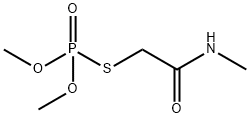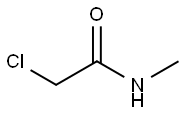Uses
Omethoate is a systemic insecticide used for the control of (mostly)
sucking insects and mites in a wide variety of crops.
Uses
Insecticidal, acaricidal, and fungicidal combinations of carboxamides and other pesticides.
Definition
ChEBI: Omethoate is an organic thiophosphate and an organothiophosphate insecticide. It has a role as an EC 3.1.1.7 (acetylcholinesterase) inhibitor, an acaricide and an agrochemical. It is functionally related to a N-methyl-2-sulfanylacetamide.
Contact allergens
Contact dermatitis from omethoate-dimethoxon is rare.
Metabolic pathway
Omethoate is the P=O analogue (oxon) of dimethoate. Dimethoate is
metabolised via oxidative desulfuration to omethoate which is the active
anti-acetylcholinesterase metabolite. This biotransformation occurs in all
media: hence the metabolic pathways of both compounds have much in
common. However, degradative pathways acting directly on dimethoate
such as O-demethylation, N-demethylation and hydrolysis of the amide
function mean that the balance between activation and degradative
metabolism will influence their respective selective toxicities. In mammals
there are two main routes of degradation: (i) glutathione transferase
mediated O-demethylation (ii) hydrolysis to N-methylthioglycolamide
which is S-methylated by S-adenosylmethionine and subsequently
thiooxidised. In soil and plants the N-methylthioglycolamide moiety
formed from the hydrolysis of omethoate undergoes a complex series
of C
1, C
2 and C
3 biotransformations ultimately leading to oxalate and
citrate respectively and total degradation to C0
2. The information
reported below is derived largely from an evaluation prepared by the
UK MAFF Pesticide Safety Directorate (PSD, 1993).
Metabolism
Orally administered omethoate to rats is
rapidly metabolized and excreted in the urine; the main
metabolites are O-demethylomethoate and N-methyl-2-
methylsulfinylacetamide. O-Demethylation and hydrolysis
of the P?S bond are main degradation routes both in
mammals and plants. Omethoate is rapidly degraded in
soils with DT
50 of a few days.
Degradation
Omethoate was slowly hydrolysed in acidic media but more rapidly
under alkaline conditions. The half-lives for hydrolysis at pH 4,7, and 9
were 102 days, 17 days and 28 hours, respectively (PM). Omethoate does
not absorb light at wavelengths above 250 nm and it is thus unlikely to be
subject to photodecomposition. An aqueous solution of omethoate was
irradiated for 14 hours with a high pressure filtered mercury vapour lamp
without detectable photolysis occurring (PSD, 1993).
Toxicity evaluation
The acute oral LD
50 for rats is about 25 mg/kg.
Inhalation LC50 (4 h) for rats is 0.3 mg/L air. ADI is
0.3 μg/kg b.w.




